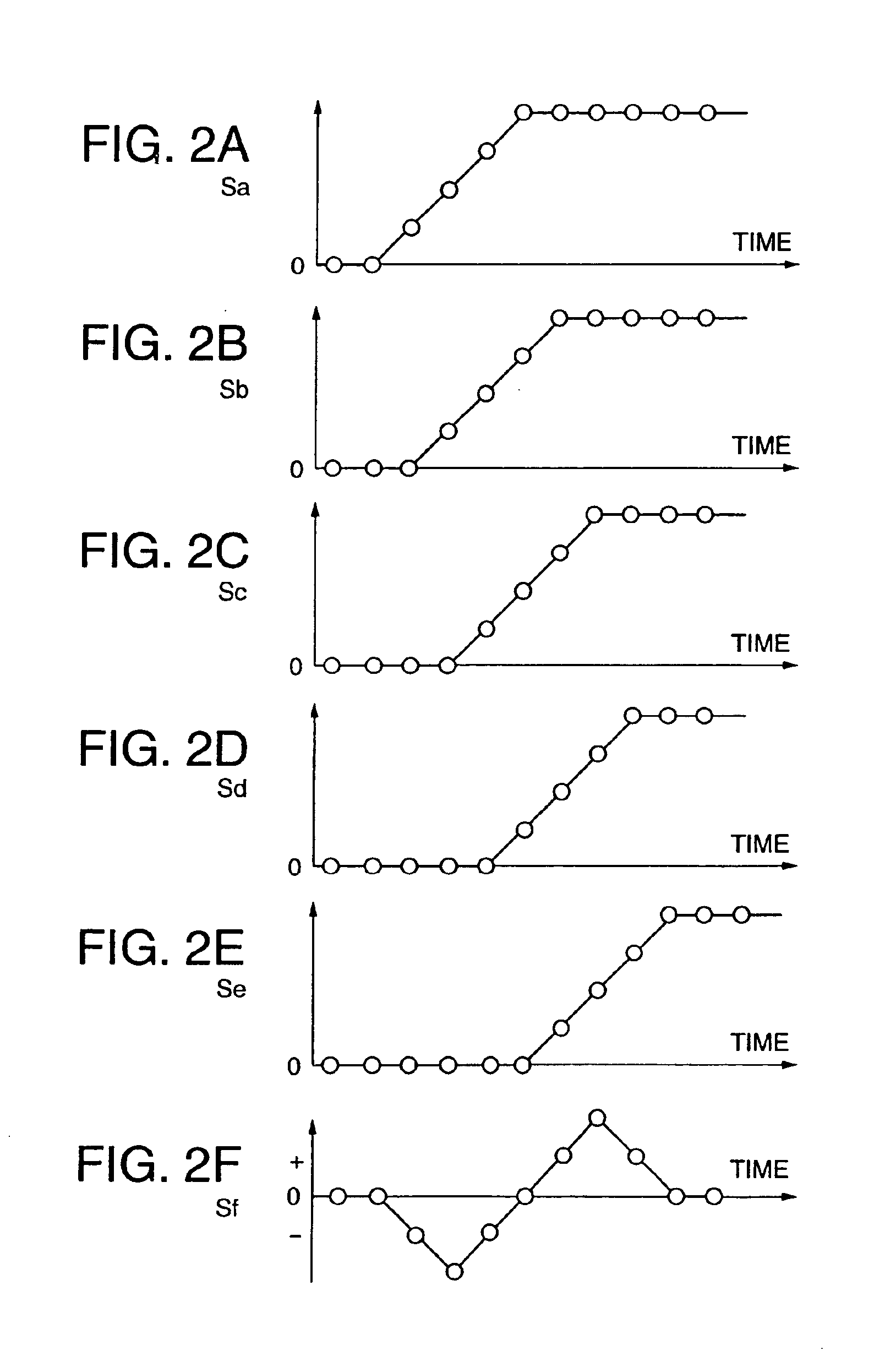Edge correction circuit
a technology of correction circuit and edge, applied in the field of edge correction circuit, can solve the problem that the necessary edge enhancement cannot be made adequately, and achieve the effect of optimizing the edge correction
- Summary
- Abstract
- Description
- Claims
- Application Information
AI Technical Summary
Benefits of technology
Problems solved by technology
Method used
Image
Examples
embodiment 1
FIG. 1 is an edge correcting circuit of Embodiment 1 of the invention. FIGS. 2A to 2F, and FIGS. 3A to 3G show signals at various parts of the edge correcting circuit.
As shown in FIG. 1, the edge correcting circuit has an input terminal 101 for receiving a digitized image signal Sa formed of a sequence of digitized pixel signals representing luminance or colors of respective pixels, four one-pixel delay units 1, 2, 3 and 4 connected in series with each other, a high-frequency extracting circuit 5, an amplitude-restricting signal generator 6, an amplitude restricting circuit 7, an adder 8, and an output terminal 102 for outputting the edge-corrected image signal.
The image signal Sa input to the input terminal 101 is delayed successively by the one-pixel delay units 1, 2, 3 and 4 to become output signals Sb, Sc, Sd and Se (FIG. 2B, FIG. 2C, FIG. 2D and FIG. 2E) of the respective delay units.
The high-frequency extracting circuit 5 is formed of digital filters, and performs a predetermi...
embodiment 2
FIG. 7 is an edge-correcting circuit of Embodiment 2 of the present invention. Signals appearing at various parts of the circuit of this embodiment are shown in FIGS. 8A to 8H and FIGS. 2A to 2F. The edge correcting circuit of this embodiment is generally identical to that of Embodiment 1, but is different in additionally having a subtractor 9, an amplitude control circuit 10, an amplitude adjusting circuit 11, and an adder 12.
The subtractor 9 subtracts the inclination-improving signal Sj output from the amplitude restricting circuit 7, from the high-frequency signal Sf output from the high-frequency signal extracting circuit 5, to produce an overshoot signal Sk shown in FIG. 8G.
The amplitude control circuit 10 adjusts the amplitude of the overshoot signal Sk, and restricts the amplitude to within a predetermined value, by clipping. The amplitude adjusting circuit 11 adjusts the amplitude of the inclination-improving signal Sj output from the amplitude restricting circuit 7.
The adde...
embodiment 3
FIG. 9 shows an edge correcting circuit of Embodiment 3 of this invention. Signals appearing at various parts of the circuit of Embodiment 3 are shown in FIGS. 10A to 10G and FIGS. 2A to 2F. Embodiment 3 is generally identical to Embodiment 1, but the amplitude-restricting signal generator 6 of FIG. 1 is replaced by an amplitude-restricting signal generator 13.
The amplitude-restricting signal generator 13 differs from the amplitude-restricting signal generator 6 in that it receives the high-frequency signal Sf output from the high-frequency signal extracting circuit 5, in addition to the output signals Sb and Sc from the one-pixel delay units 1 and 2, and generates, therefrom, an amplitude-restricting signal Si for removing the overshoot components.
FIG. 11 shows details of the amplitude-restricting signal generator 13 of FIG. 9. In FIG. 11, reference numeral identical to those in FIG. 5 denote identical or corresponding members. As illustrated in FIG. 11, the amplitude-restricting s...
PUM
 Login to View More
Login to View More Abstract
Description
Claims
Application Information
 Login to View More
Login to View More - R&D
- Intellectual Property
- Life Sciences
- Materials
- Tech Scout
- Unparalleled Data Quality
- Higher Quality Content
- 60% Fewer Hallucinations
Browse by: Latest US Patents, China's latest patents, Technical Efficacy Thesaurus, Application Domain, Technology Topic, Popular Technical Reports.
© 2025 PatSnap. All rights reserved.Legal|Privacy policy|Modern Slavery Act Transparency Statement|Sitemap|About US| Contact US: help@patsnap.com



